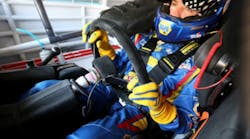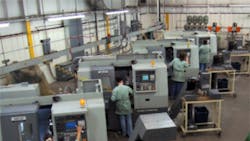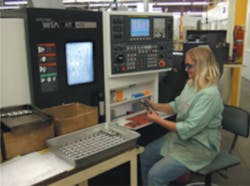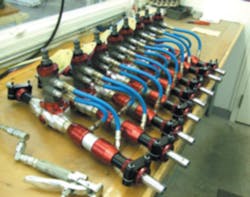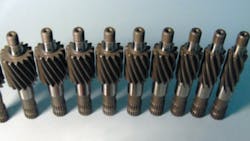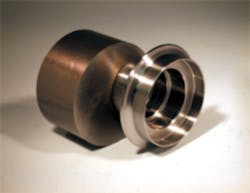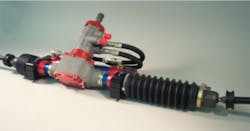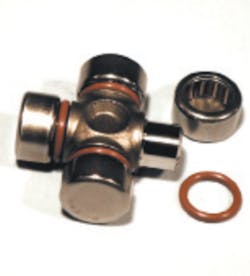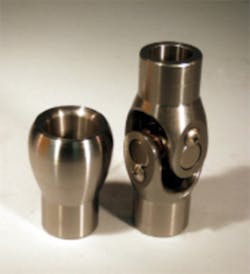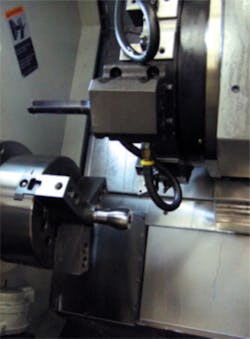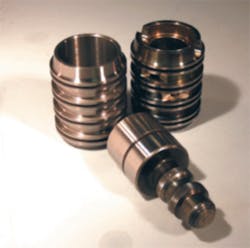Tony Woodward founded Woodward Machine Corporation in 1978 in a Maryland suburb of Washington D.C., as a job shop specializing in racecar fabrication and general repair.
In 1980-1981 he dreamed up a rack-and-pinion steering package for dirt-track stock cars, and started producing it on manual equipment, mostly salvaged from scrapyards and rebuilt. The only new machine in the shop was a Bridgeport.
His competitors in the racing components industry were all CNC-equipped, but he thought he might be able to compete successfully with manual equipment if they could just take the plunge — drop all job-shop work — and dedicate every machine to a single operation to eliminate setup time.
By 1984 the shop had built a lot of single-purpose machines, and the castings were being walked through a sort of poor man's transfer line. It made sense to do it that way because these were magnesium castings, and cutting magnesium in an enclosed machine, with water-based coolant is a fire hazard. However, the operators had to continually sweep up and dispose of the magnesium chips, and that alone became a huge time sink.
Over the next several years Woodward Machine added a great many new products — mostly turned workpieces to its line of steering components, making the company even more dependent on manual machines and experienced machinists. Tony Woodward began to realize that the labor-intensive technology of 1935 had its limits.
So, in 1991 the shop acquired a used Ikegai FX20N turning center to help machine round parts. Woodward spent months trying to teach himself CNC programming from the Fanuc manuals, but finally one evening he and his wife Gloria found themselves eating takeout while the machine made parts all by itself. It was a defining moment.
“We knew that from then on we would be transitioning the company to CNC,” Woodward said, “initially through used machines but ultimately through the newest technology applicable to our products. Eventually our adoption of CNC led to abandoning magnesium castings in favor of aluminum and eventually acquiring a stable of Hyundai WIA turning machines.”
Heading West
By 1992 the business was doing well enough that Woodward bought a building lot in a southern Maryland industrial park, intending to build his own plant. Unfortunately the U.S. Fish and Wildlife Service intervened by designating the property a "wetlands." As others have discovered, it proved impossible to build while meeting federal environmental restrictions. Woodward gave up, "remediated" the lot by replanting the mandated vegetation, established a conservation easement, and started looking for a more industry-friendly location.
“We then spent three weeks going up and down the East Coast, starting with New Britain, Conn., and we went all the way to Hampton, Va.,” Woodward said. “We stood in the every piece of industrial property that was empty, all in three weeks. They were all empty for pretty good reason, … For example, there was a lovely building in southeastern Pennsylvania that had originally been a flag factory, and it had very, very intense lighting, which is a wonderful thing. It was empty because that area had as many as eight overlapping jurisdictions with taxing authority, so there would have been eight deductions from everybody's paychecks.
“So you can imagine a business having to deal with all those taxes plus foreign competition,” he recalled. “And that woke us up: Any place that was somewhat urbanized was greatly inflated, overinflated, price-wise.
“So we went back to our shop in Maryland and were pretty deflated. I was reading a magazine called Industrial Machine Trader, and in the classifieds there happened to be an ad, a black-and-white picture of an industrial building out on the prairie with nothing else visible in the distance, and it said, ‘Campbell County, Wyoming, lots of industrial buildings and land for sale cheap,’ and a phone number. And I said to Gloria, what about Wyoming? And she said, you must be kidding. I don't even know where that is.”
So, the Woodwards got some listings in Campbell County, Wyo. Someone suggested they look in Casper, because that city had three oil refineries, two of which had closed during the 1980s.
They started to collect listings from Casper, very attractive listings. City officials showed them around, a town of about 50,000, urbane without being urban, nicely maintained and restored buildings, clean streets, good places to eat, and so on. After seeing the third building, a one-time welding school, the Woodwards were ready to make an offer. It had been empty five years, but was well equipped.
“Gloria, who is the CFO of our company organized the transition, and it was 13 days in April of 1993 between the time that riggers began to unhook machines in Maryland to the time that we shipped the first product manufactured in this plant in Wyoming — 13 calendar days. That was amazing,” Tony Woodward said. “But just as amazing is what we paid for this new building in Wyoming was roughly one-third the cost of equivalent square footage in Maryland.
“Further, Wyoming had no state income tax, no corporate tax, no inventory tax, and no emissions testing,” he recalled. “They didn't even have motor vehicle inspection. In short, there's not a lot of jurisdictional overhead here. Twenty years later it still ranks as the smartest business decision we ever made, because it enabled us to grow into better technology.”
The Shop for the Job
The shop covers 15,000 sq.ft., with 12,000 sq.ft. for the production floor. The Woodwards have expanded the operation several times since 1993, and each expansion has been financed directly from earnings.
The original building already had 480-volt three-phase power supply, and overhead busways. Now, Woodward Machine has a staff of ten, for the most part single moms who have retrained for industrial careers.
The products are racecar steering components, including gears, racks, needle bearing universal joints, collapsible safety steering columns, and steering wheel quick releases. If you watch any NASCAR event, you will see the Woodward logo in the in-car camera shots. 'The team manufactures its own hydraulic power steering in-house, including the hypersensitive directional control valve. Virtually all other systems marketed for racing use OEM valve components; Woodward is one of just a few companies in the world that makes those parts. They have a distributor in the EU distributor, a growing market for Woodward’s precision steering products.
“We machine our gears and valve components from 41L42 and 41L50. The typical part size is from three-quarter inches up through 1-5/8” diameter by up to six inches long,” Woodward explained. “Although we eventually grind these parts to size after hardening, some of them require intermediate operations, such as hobbing and milling, which absolutely must start with an accurately turned and centered workpiece.
“So, just about all our parts have to be held within 0.001 in. on the diameter right from the first operation. We do all of our turning with cermet inserts, and we find that with the Hyundai WIAs we can run near the upper limit of SFM, which is where those inserts really shine,” he said, adding for emphasis: The harder grades of cermet are vulnerable to thermal shock, so we turn steel dry.
“We also make a lot of ‘commodity’ parts that many companies would farm out, such as crimp-style hydraulic hose ends and various non-heat-treated fasteners and other hardware for our products. The material for these ranges from 12L14 up through ETD 150, in diameters up to 2 inches.”
ETD 150 is a trademark material of the LaSalle Steel Co., which patented the process. It's basically a 4142 material that has been drawn through dies at an elevated temperature, not as high as normal forging temperature, but just high enough to allow the material to be reduced in cross section by two-thirds in one pass. The result is a material that from this plastic deformation, from this working, has an almost uniform hardness from the outside to the inside. That generally is not true of heat treatable steels except for very high alloy steels like 4340.
Many of the “bulkier” racecar parts the shop produces are aluminum products. “On our older, slower turning centers it was sometimes necessary to use an expensive free-machining grade like 2011,” Woodward said, “but with the RPM capability of the Hyundai WIAs we've been able to use 6061 which is better for color anodizing, not to mention lower in cost.”
Taking On Tough Work
A typical job might be a 3-in. diameter steel part turned from a slug … the pull ring for a NASCAR steering wheel quick release unit. It's quite thin, with less than 5% of the material left after machining. The rest is chips. “For an old lathe hand like me there are few things more satisfying than being able to rip steel off to the absolute limits of the holding power of the chuck, without chatter and without compromising the finish or accuracy. The Hyundai WIAs will do that, in spades,” Woodward said.
For bar work, the operators change out liner bushings and chuck jaws, download the program, touch off the tools, graph it, and go.
For second operations they'll rebore the jaws first. In the interest of speed Woodward doesn’t get too upset if a few parts are sacrificed while fine-tuning the offsets, at least in the initial stages of the part. In a job shop it would be different, but here if they get 495 first-operation parts instead of 500 it doesn't matter. The convenience of the Hyundai WIAs has allowed shorter runs than had been the case with the older turning centers.
“We view these newer Hyundai WIA machines as replacements for our older turning centers: higher RPM, quicker rapids, and a sophisticated control,” Woodward declared.
“Around 2006, it came time to replace the aging Ikegai's,” he recounted. “We evaluated everything on the market for bar capacity, RPM and rapid traverse speed. Now, 4,000 RPM with a 2.5-in. bar capacity was pretty far beyond anything made in the U.S. (and for all I know still is) so the advertised specs for the then Hyundai Kia SKT-21 (currently known as the Hyundai WIA L210) didn't sound real — especially not for the price. So we visited a shop that was using the next smaller model, and after watching the guy bust through a slug of unleaded 4140 with about a 2-in. insert drill we were believers.
“Also, the Fanuc control meant we could run all our old programs,” he noted. “We now have a line of four L210s. Our operators — again, almost all women — like the ergonomics of the tooling and the quick setup with the Q-Setter.”
Woodward said they turn the bearing trunnion (also known as a bearing "cross") for universal joints directly to finished size from a 6150 near-net-shape investment casting pre-hardened to 60 RC. That hardness requires straight ceramic, also without coolant. The finish and tolerance are what you might expect for a 3/8-in. inner bearing race with zero radial clearance. Since 1989, the shop had been manually hard-turning this part using a highly modified chucker. The main obstacles to holding close diameters in dry hard turning are the thermal effects and the high concentration required of the machinist. In other words, a very, very difficult job where you get weary.
KIT450 Boosts Production
Recently, the motorsport divisions of several major European car manufacturers have adopted Woodward U-joints. Once the sales of this product grew beyond NASCAR and related American racing series, the production rates began to fall behind. What to do?
“The tolerances we had always held are such that nobody would confidently quote a robot-loaded centerless grinder,” according to Tony Woodward, “one of the traditional ways of finishing such parts (which would still need to be rough-turned).
“Reasoning that programming can duplicate most any manual technique, provided the variables can be held to an absolute minimum, we decided to replace the chucker with a dedicated turning center,” he continued. “Within that category a gang-tool machine seemed to resemble our existing process most closely, which had bee proven to work. Since by this time we'd already had four Hyundai WIA L210s working beautifully for five years, it made sense to investigate the broader Hyundai WIA line. We decided on a KIT450.”
The Hyundai WIA KIT450 is a compact CNC lathe featuring gang-type block tooling, which is ideal for processing small diameter, high-precision parts. It is supplied with a gearless spindle designed for high-precision applications, with features that ensure minimal thermal growth at high speeds. High-precision double-nut ball screws drive all axes, and rapid high-speed axis movement is achieved by the use of linear motion guideways.
“Most of today's machinists are aware of the debate over box-way versus linear-motion guideway machines for cutting steel,” Tony Woodward confided, “and I had some doubt as to whether the required finish in hard steel could be held with a ‘live’ tool slide. Of course, a KIT450 weighs several thousand pounds more than the chucker, so worrying about stability seemed kind of silly.
“Also, the machine has a fire-hose coolant supply that, although it couldn't be run during a cut could certainly be programmed to thermally stabilize the part during the process,” he added. “Some trial and error was required to bring it to room temperature in the machine but it definitely worked.
“After a day and a half of tweaking the toolpath and coolant dwell time I had the new KIT450 holding +/- .00013 in., which was above my expectations,” he said. “The next day the regular operator applied a few more tricks and was easily holding +/- .00010 in. After establishing the edge life (much longer than before, which I ascribe to the machine's heavy slide, massive toolholders, and general rigidity) they have it down to somewhat tighter than that now, and the dimensions are honest, and the finished journals have no taper or waviness.
“I should emphasize that this is being done with plain ceramic inserts costing about $1 per edge, not PCD,” he added.
“Among automotive industry suppliers, the production of the U-joint trunnion is viciously competitive, such that some very clever methods are employed,” Woodward continued. “One is the traditional indexing-on-the-fly chuck. Another is to crush-weld two lengths of bar stock across each other. In all cases the tolerances are those of the automotive industry, that is, practical for multi-million-unit production--a different animal from supplying parts for hand-built racecars.
Outperforming the Competition
“Our competitors in the performance industry either buy their trunnions or make them by inserting four pins into a central block. That is known as ‘block-and-pin’ construction and is how ordinary machinery U-joints are usually made. It goes without saying that in a small space a one-piece, hardened alloy steel part is the strongest, but the real trick is to make a one-piece part not only accurate on the diameters, but with opposite journals concentric and parallel, and with all four accurately indexed at 90 degrees,” Woodward explained.
“The prize for solving that particular set of problems is leadership in a niche market, which was hard-won, and which we can't afford to give away by any means, including filing for a patent on the method,” he confided.
The part cycle time compared to the old method is about the same, except that more cuts are taken in the same elapsed time. The real improvement is that the scrap rate due to thermal effects has gone from over 5% to virtually zero — and nobody gets tired. At the end of the day they have about 50% more parts, all of uniformly high quality, and this can be repeated indefinitely by any of the Woodward operators, with complete confidence in the process.
Overall the Hyundai WIAs have needed minimal service. Periodically, worn parts are replaced, like the X-axis way cover. That task is done in about ten minutes, according to Tony Woodward. The sheet metal is very well arranged, and service access is exceptional, he added. Turning a setscrew activates a hinge and the entire front panel behind the control will swing wide open, a feature he said he had never seen anywhere.
“Jend Machinery's resources include two of the best-known machine and control experts in the Rocky Mountain region,” he said, name in Gary Osborne, the service manager, and Rex Winberg, the application specialist. “I'd have to rate Jend's installation thoroughness and general sales follow-up as second to none, and I expect there will be a lot more Hyundai WIA machines in the region as word gets around,” Woodward said.
